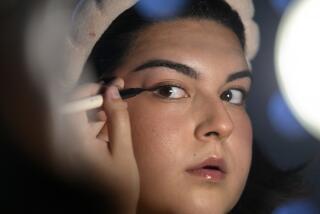Snapchat drives trend toward vertical videos
- Share via
Whether it’s in a movie theater, on TV or on a computer screen, the videos you watch have almost always been horizontal.
The rise of smartphones has quietly rotated that standard 90 degrees, with people — particularly young mobile users — flouting long-held ideas about the “right” way to capture video.
On Snapchat, one of the most popular apps among teens and twentysomethings, vertical videos have become the norm. Sensing the shift, the Venice company has embraced the atypical format and is betting that whether users realize it or not, they prefer watching videos on the go that are tall and narrow instead of short and wide.
The company is so confident in the future of vertical video that it announced last month that it had partnered with WPP, the world’s largest advertising agency, and the Daily Mail to form Truffle Pig, an ad agency whose specialties will include vertical video ad development.
With more than 100 million users and 2 billion video views daily, Snapchat’s acceptance is forcing its competitors and advertisers to reconsider video formats as well.
Last month, Twitter started showing landscape videos after only allowing square videos. Facebook recently began playing vertical videos on smartphones in full screen and now plans to sell vertical video ads. YouTube says it’s “looking into” vertical, and some start-ups are building apps and hardware that treat vertical video as a distinct art.
The cardinal rule for video has been to shoot in horizontal mode, which caters to people’s horizontally spread eyes. But smartphones are built vertically to take into account the distance between the ears and the mouth.
YouTube and other early apps encouraged users to turn their phones to make video viewing familiar. But Snapchat rejected the approach, launching four years ago with buttons on the app placed in such a way that shooting and watching videos with the phone upright would feel more logical.
It was a risky strategy, given the wide usage of landscape video and the disdain for portrait mode. But the calculated choice by Snapchat Chief Executive Evan Spiegel, who studied product design at Stanford University, was ultimately a wise one. Mobile users have become comfortable reading emails, scrolling through photos and watching videos without rotating their phones.
On smartphones, about 94% of website visits across the world begin in portrait mode, according to ScientiaMobile, which tracks more than 1 billion Internet browsing sessions each month.
“Now that everything is on cellphones, it’s more valuable to shoot content vertically,” said entertainer Shaun McBride, whose Snapchat videos are viewed by hundreds of thousands of people. “It’s not necessarily that vertical is better, it’s just that it’s how cellphones are commonly viewed.”
McBride, 28, who goes by the Snapchat user name Shonduras, said he appreciates the in-your-face perspective of vertical videos and the fact that it feels natural.
“If something cool happens — a deer runs across the road — you don’t think, ‘I’m going to turn my cellphone horizontally and get a really good shot,’” he said, noting that “99.89%” of the Snapchat messages he receives from fans are in portrait.
Digital media executives don’t expect two-hour movies in portrait mode to appear any time soon. But as people increasingly replace thumbing through TV channels with tapping on smartphone videos, it’s hard to see vertical’s upswing slowing. That is turning shooting in vertical, once an anathema in Hollywood, into a real consideration in certain cases.
If more apps that prioritize vertical videos emerge as platforms in which content producers can make money, it’s going to become “very worthwhile to put resources toward building vertically,” said Kathleen Grace, chief creative officer of online video studio New Form Digital.
That has major implications for online video ads, a fast-growing industry that is expected to reach $2.6 billion in revenue this year in the U.S., according to EMarketer.
Since first appearing last fall, all video ads on Snapchat have been vertical, including promo spots for Tide detergent, “Jurassic World” and the Samsung Galaxy S6 Edge.
In recent months, Snapchat’s Spiegel trumpeted the initial success of those vertical video ads in an Adweek cover story, at a big digital advertising conference and during the Cannes Lions International Festival of Creativity in France.
The company says quick videos ads that fill vertical, or portrait, displays are nine times more likely to be watched than the horizontal, or landscape, ads found on most other websites and apps.
Now, with its new Truffle Pig ad agency, the company is going a step further. The aim is to get advertisers to recognize vertical as the preferred mobile screen orientation among consumers, and subsequently make it easier for advertisers to create vertical ads by providing them with a suite of portrait-centric insights and tools.
“Sometimes, you can’t imagine something is better or more dynamic until it comes,” said Alexander Jutkowitz, an advertising veteran who is Truffle Pig’s CEO. “Well, it has come and we should see what we can do with it.”
Jon Gieselman, senior vice president of marketing for DirecTV, said advertisers will be excited to take advantage of the new flexibility offered by vertical video ads on smartphones.
“Is it going to change the industry? No,” he said. “But vertical can sometimes be more impactful.”
Some in the entertainment technology industry are unsure where portrait goes beyond Snapchat. Would people really want to watch a “Game of Thrones” episode or a baseball game vertically on their phones? Is it the app, the content or the ergonomics driving the behavior?
So far, Google-owned YouTube is standing by landscape. Portrait video in YouTube’s app displays in a tiny frame with black bars on the sides, and Google’s Camera app encourages capturing video in landscape mode.
But several start-ups are starting to push vertical, or at least embracing both screen orientations.
Video-streaming app Stre.am was designed for portrait or landscape viewing and horizontal filming. Now, the start-up is developing technology to allow horizontal capture while maintaining a portrait grip, Chief Technology Officer Jeremy Martin said.
San Jose start-up Vervid, meanwhile, wants to be the vertical YouTube. When Chief Executive John Whaley noticed angry YouTube commenters criticizing video owners for shooting vertically, he saw an opportunity in the friction between video purists and the selfie generation. His app makes vertical videos look attractive by displaying them in full screen, with no black bars, and high quality.
Even big TV screens are now hanging the long way. Enplug, a Culver City start-up that specializes in real-time digital signage software for businesses, initially installed screens vertically so that the surprising orientation would draw people’s gazes, said Ryan Gushue, the start-up’s marketing director.
The company now lets customers handle installation, with about 1 in 4 choosing to hang their screens vertically.
Snapchat propelled the vertical video movement forward. But Chris Swain, a design expert who has taught video-game-making at USC, also credits the iPhone with changing long-held rules about the look of content. These days his phone’s camera roll is filled with both portrait and landscape images taken, he said, “with no rhyme or reason.”
“It’s about what feels right,” he said.
Snapchat: peard33
More to Read
Inside the business of entertainment
The Wide Shot brings you news, analysis and insights on everything from streaming wars to production — and what it all means for the future.
You may occasionally receive promotional content from the Los Angeles Times.











